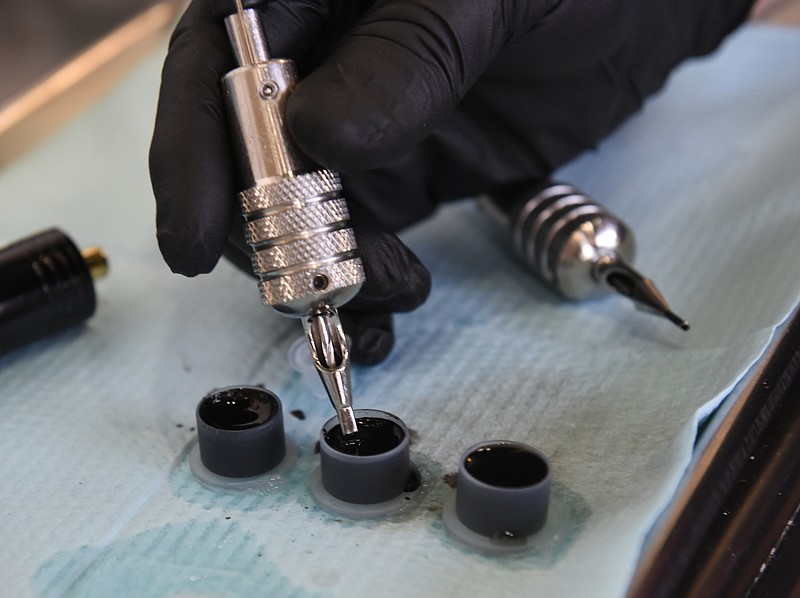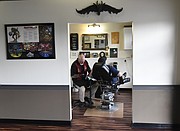What to Expect from Laser Removal
Requires three to five sessions spaced four to six weeks apart to remove most tattoos.May cause mild discomfort, similar to getting a tattoo. If desired topical anesthetic can be provided.Picosure lasers obliterate the ink, shattering it into tiny particles that are then absorbed by the body.Is most effective with fair-skinned patients. Dark-skinned patients may experience some loss of skin pigmentation which can be temporary.Source: Southern Surgical Arts in Chattanooga
The beautiful naked lady on Charles Harper's arm was created in prison by a talented artist who carved a guitar pick into a needle then used smuggled ink to sink the woman into his skin.
Harper's life was already inked onto skin via tattoos collected from his days as a popular Chattanooga DJ working concerts, strip clubs and bars. There also was some darker art added to his body as he began dealing drugs and abusing meth and Ecstasy.
But when Harper changed his life utterly and dramatically, he knew his skin had to change.
"I accepted Jesus as my savior and, when I got out of prison, my goal was to be a drug and alcohol counselor," Harper explains. "I didn't want an image that was disrespectful to women."
At first, he had a black bar tattooed across the nude woman's breasts, his way of telegraphing to observers that he was saying "No" to pornography.
But when he noticed two little boys staring and giggling at the half naked woman on his arm, he decided to erase all his tattoos that no longer reflected his spirituality.
Tattoos are the only art form that the buyer connects with so deeply, he or she offers their body as a permanent canvas. The images often telegraph the wearer's past as well as future dreams and can reflect a spiritual journey.
But tattoo artists often meet clients like Harper who no longer cherish or even want the inked-in attitudes they have memorialized on their skin. Pew Research noted last year that tattoos are a $1.6 billion industry in the U.S., yet 72 percent of Americans with more than one tattoo keep them hidden from strangers.
Some are shy or, like Harper, regret a tattoo they once enjoyed. Some just got crummy drawings; some want to get rid of tattooed names or portraits of ex-lovers who've been dumped - or who are doing the dumping; some have tattoos that are far more grim and dark than they currently feel in their lives.
"Tattoos are a storybook of your life," says Main Line Ink artist Lynn Buckner, an expert at tattoo coverups and alterations. "A tattoo you loved now looks silly or too grim. You can figure it's a signpost of where you once were on your spiritual journey and decide to keep it. But some people decide that part of the journey isn't something they want to share with everyone who sees their ink."
Cover ups
In the tattoo parlors, there are several removal methods. Singapore artist Chester Lee's Instagram is credited with popularizing blackout ink, so the entire body part - arm, chest, throat, hand - that is emblazoned with an unwanted tattoo is covered with jet-black ink. But most tattoo regretters prefer to transform an existing image or cover the regretted tattoo with a totally new picture.
In Harper's case, he went to Daniel "Bones" LaLonde, owner of Freedom Tattoo in Hixson, to cover the naked lady with the three crosses on Calvary where Christ died between two thieves. LaLonde says he uses a method that, bit by bit, makes a tattoo eventually fade away.
"I use a needle to add a white pigment to the existing pigment in the tattoo the client wants to remove," LaLonde explains. "It makes the pigment lighter and lighter. Some tattoos will need more than one treatment, but I leave plenty of time between treatments so there isn't too much stress on the skin."
Harper still gets new tattoos and alters older ones at Freedom. One of the older ones, a beautiful leopard, had faded down to its spots so he wanted it removed. LaLonde used his white pigment method to make the tattoo fainter with each application.
"A tattoo never really goes away completely," Harper says. "Sometimes I can see bits of the outline of an old tattoo under a new one."
Medical methods
While some tattoo clients go back to the tattoo business to cover up or lighten their tattoos, others go the doctor route. When that happens, lasers are used.
Southern Surgical Arts in Chattanooga uses the Picosure laser, which is widely touted as not leaving a scar. Picosure works best with black, blue, green and purple tattoos and is not recommended for red tattoos.
"In the last few years, laser technology has made a revolutionary leap from the old diode lasers that would remove a tattoo by basically burning the pigment away," says Southern's Dr. Chad Deal. "But the diodes didn't distinguish between the skin's natural pigment and tattoo pigment, so both would be burned and there was the risk of a scarring."
Picosure, he says, "hits the skin at one trillionth of a second to pulverize the tattoo pigment into millions of microscopic bits so tiny the body's immune system simply absorbs them."
Like LaLonde at Freedom, Deal says some tattoos take more treatments, so Southern doctors allow time between so the skin can recover before the next go-round.
Transformation
Realtor Angela Pierce came to Main Line for an urgent tattoo correction. At a different studio, she asked one of the artists for a tattoo of a heart-shaped pincushion holding pretty pins like a seamstress would use to tailor a garment. When he said he was halfway done, she looked at the image and wanted to leap screaming from the chair. The heart looked like it was hammered full of nails and about to explode into shrapnel.
"It looked angry," Pierce remembers. "When I got home, my husband laughed and thought I was teasing him with a fake tattoo. I started crying."
At Main Line, artist Jennifer Edge gentled the raging reds into girly pinks and transformed the nails into cute pins, then tweaked the heart into a plump 3-D pin cushion. She also created an exquisite tattoo of bluebirds and tree leaves twining up the forearm of Pierce, who says it's a reminder of the bluebird houses she and her dad built together when she was a child.
"It's a wonderful memory I'll never regret and what I like about it is that, even though it's visible on my skin, the meaning is a secret unless I share it," Pierce says.
Her own real estate clients have never had a negative response to any of her tattoos, she adds.
"In my business, a goal is to turn the want-to-meets into the have-mets. This form of art is a nice icebreaker."
SOMETHING NEW
Main Line's Buckner, with his long brown hair and mustache, exudes patience and thoughtfulness, a persona and manner that can give him the air of a counselor or therapist.
"Sometimes, that's a role I try to take if a client seems like he needs to talk through the emotions that drove him to want a tattoo," Buckner says. "I'd rather turn away money than give a client a tattoo he will regret."
One of Buckner's clients, for instance, had grown tired of a bicep tattoo of a man on a bench playing a guitar.
"The client wanted it covered with a unique tattoo that he could connect with emotionally," Buckner says.
He obliterated the generic music man with the lush bronze, plum and coral of dawn expanding across a horizon as leaden-gray storm clouds clear from the sky. A black iron drawbridge soars above a wave-tossed river that reflects a swirl of sunrise that deepens into dark blue in the river above the man's elbow, a scene hinting at the exhilaration of exploration and adventure.
"Two of the most effective ways to hide an old tattoo are by using texture, that would be here," he says, running his finger along the choppy, shimmering water that incorporated curves and angles from the old tattoo, "and distraction", he adds as he points to the luminous sunrise colliding with the storm clouds.
But even the most talented artist can encounter a regretted tattoo that can't be changed. If a client came in with a blackout tattoo, for example, covering his entire chest in ebony and asked Buckner to remove it, what would Buckner say?
"I can't," Buckner replies with a sigh.
Contact Lynda Edwards at 423-757-6391 or ledwards@timesfreepress.com.

